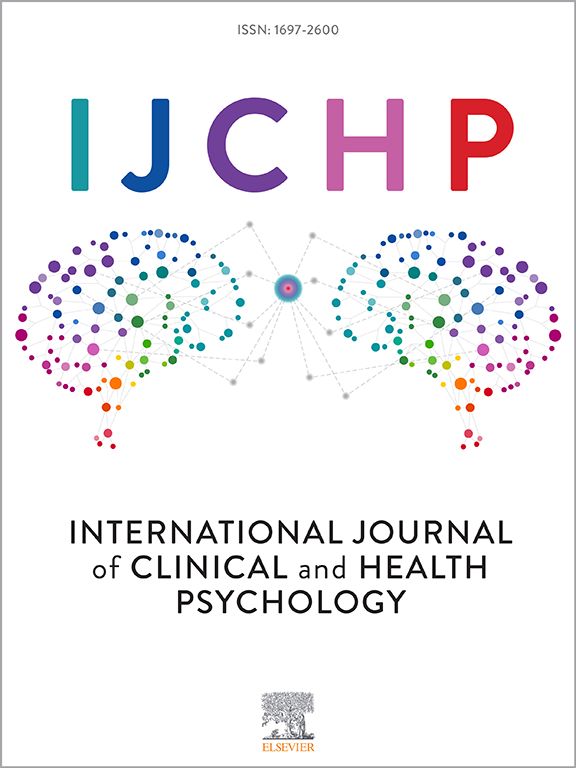The longitudinal impact of screen media activities on brain function, architecture and mental health in early adolescence
IF 4.4
1区 心理学
Q1 PSYCHOLOGY, CLINICAL
International Journal of Clinical and Health Psychology
Pub Date : 2025-06-14
DOI:10.1016/j.ijchp.2025.100589
引用次数: 0
Abstract
The increased use of screen media has raised unknown effects on mental health among adolescents. This study aimed to examine the correlational and causal association between screen media activity (SMA) and mental health problems, and the mediating role of brain functions and structures in this relationship.
Data from 4557 adolescents (mean age = 9.955 ± 0.164 years) in the Adolescent Brain Cognitive Development (ABCD) study were analysed across four time points: baseline, 1-year, 2-year, and 3-year follow-ups. Linear mixed models assessed SMA’s association with mental health indices and the brain's developmental pattern, respectively. Cross-lagged panel models examined the SMA-mental health problems’ longitudinal and causal relationship. Mediation analyses explored brain functions and structures as mediators on the SMA-mental health correlation.
Baseline SMA positively correlated with internalizing, externalizing, and stress problems; and negatively correlated with brain volume, area and diverse sets of resting-state functional connectivity (RSFC) after three years. Higher baseline SMA associated with increased internalizing (β = 0.030, SE= 0.012, pfdr = 0.016), and stress problems (β = 0.026, SE = 0.012, pfdr = 0.037) three years later. The RSFC between the cingulo-opercular network (CON) and the retrosplenial temporal network (RTN) mediated the effects of SMA on externalizing (β = 0.002, pfdr = 0.042) and stress problems (β = -0.003, pfdr = 0.022). TV watching predicted higher externalizing problems (β = 0.054, pfdr < 0.001), while video watching predicted increased internalizing (β = 0.061, pfdr < 0.001), externalizing (β = 0.033, pfdr = 0.035), and stress problems (β = 0.060, pfdr < 0.001).
The findings indicate the negative impact of SMA, particularly TV and video watching, on adolescent mental health, mediated by changes in CON and RTN functional connectivity. Future research can explore the specific risks associated with video streaming and consider the role of emerging technologies such as virtual reality in SMA on adolescent mental health.
屏幕媒体活动对青少年早期脑功能、结构和心理健康的纵向影响
屏幕媒体使用的增加对青少年的心理健康产生了未知的影响。本研究旨在探讨屏幕媒体活动(SMA)与心理健康问题之间的相关关系和因果关系,以及大脑功能和结构在这种关系中的中介作用。在青少年脑认知发展(ABCD)研究中,4557名青少年(平均年龄= 9.955±0.164岁)的数据在四个时间点进行了分析:基线、1年、2年和3年随访。线性混合模型分别评估了SMA与心理健康指数和大脑发育模式的关系。交叉滞后面板模型检验了sma -心理健康问题的纵向和因果关系。中介分析探讨了脑功能和脑结构在sma -心理健康相关性中的中介作用。基线SMA与内化、外化和压力问题呈正相关;3年后与脑容量、脑面积、静息状态功能连接(RSFC)呈负相关。较高的基线SMA与三年后内化(β = 0.030, SE= 0.012, pfdr = 0.016)和压力问题(β = 0.026, SE= 0.012, pfdr = 0.037)的增加有关。扣带回-眼窝网络(CON)和脾后颞网络(RTN)之间的RSFC介导SMA对外化(β = 0.002, pfdr = 0.042)和应激问题(β = -0.003, pfdr = 0.022)的影响。看电视预测较高的外化问题(β = 0.054, pfdr <;0.001),而视频观看预测内化增加(β = 0.061, PFDR <;0.001),外化(β = 0.033, PFDR = 0.035)和压力问题(β = 0.060, PFDR <;0.001)。研究结果表明,SMA对青少年心理健康的负面影响,尤其是电视和视频观看,是由CON和RTN功能连通性的变化介导的。未来的研究可以探索与视频流相关的具体风险,并考虑SMA中虚拟现实等新兴技术对青少年心理健康的作用。
本文章由计算机程序翻译,如有差异,请以英文原文为准。
求助全文
约1分钟内获得全文
求助全文
来源期刊

International Journal of Clinical and Health Psychology
PSYCHOLOGY, CLINICAL-
CiteScore
10.70
自引率
5.70%
发文量
38
审稿时长
33 days
期刊介绍:
The International Journal of Clinical and Health Psychology is dedicated to publishing manuscripts with a strong emphasis on both basic and applied research, encompassing experimental, clinical, and theoretical contributions that advance the fields of Clinical and Health Psychology. With a focus on four core domains—clinical psychology and psychotherapy, psychopathology, health psychology, and clinical neurosciences—the IJCHP seeks to provide a comprehensive platform for scholarly discourse and innovation. The journal accepts Original Articles (empirical studies) and Review Articles. Manuscripts submitted to IJCHP should be original and not previously published or under consideration elsewhere. All signing authors must unanimously agree on the submitted version of the manuscript. By submitting their work, authors agree to transfer their copyrights to the Journal for the duration of the editorial process.
 求助内容:
求助内容: 应助结果提醒方式:
应助结果提醒方式:


